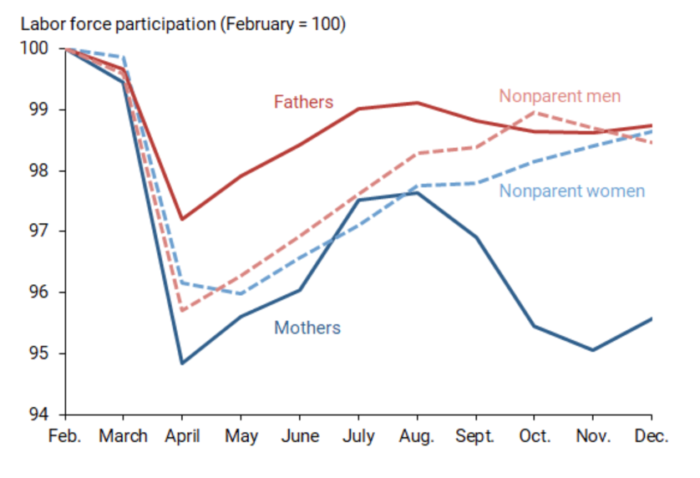
The Pandemic and Women in the Workforce
The pandemic brought chaos to the U.S. employment market, and whether you lost your job altogether or had to change the way you work, you’ve likely felt the impact. But we now know that the pandemic economy had disproportionately negative consequences for women in the workforce. And according to Gallup, “Despite better-than-expected job market gains last month, women are still lagging men in the jobs recovery.” Let’s explore the issues that impacted working women during the pandemic and what can be done to improve their recovery.
Workforce Trends for Women
Research shows that labor participation rates were increasing for women prior to the pandemic. In fact, from 2015-2020, the participation rate for women was 300% greater than that seen for men. During that same time period, McKinsey’s multi-year study with LeanIn.Org indicated that, while still significantly underrepresented, female participation in corporate leadership was increasing and their attrition rate was lower than their male counterparts.
When the pandemic hit, labor force participation rates fell dramatically for both men and women, but the drop was much greater for women. By the summer of 2020, both groups slowly returned to work, but men returned in much greater numbers.
The economy, and labor market, are improving in 2021, but women are not sharing equally in that recovery. Gallup reported in March, “The gap in labor force changes amounts to roughly 493,000 more women than men [still] being absent from the labor force since the pandemic began.” McKinsey also predicts that, on average, it will take women 18 months longer to recover from unemployment than men.
Why the Pandemic Hit Women Harder
There are two factors that have heavily impacted women during the pandemic. The first, and hardest hitting, is childcare: the burden of caring for and educating children while daycare and schools were closed. The second is women’s occupational differences: a higher concentration of women in industries hardest hit by the pandemic.
When the economy shut down in March 2020, so did schools and daycare facilities. Parents who weren’t laid off were immediately challenged with balancing work responsibilities and childcare; those with school-aged children had the added burden of supervising (and even teaching) schoolwork. American social norms suggest that this this burden would fall unequally on women. Gallup backed up this assumption with their research.
“Women have been far more likely than men to cite the need to provide childcare for children out of school. Twenty-three percent of women with children enrolled in school gave this response in April [2020], and 28% in January [2021] — compared with 11% and 12% of men with children enrolled in school, respectively.”
This graph from the Federal Reserve Bank of San Francisco differentiates participation between men and women as well as between women with and without children. It’s clear that women without children rebounded at a much healthier rate than those with children. The participation rates of mothers went into a freefall when school began, attributed to the fact that most children began the 2020-2021 school year with online or hybrid learning, and schools provided little guidance on when normal, full-time schedules would resume.

Source: Federal Reserve Bank of San Francisco
There are other compounding factors that have impacted working mothers. For example, single mothers make up 80% of single-parent families, according to the U.S. Census; without another parent to lean on, single mothers may have relied on federal assistance and stayed at home longer. In addition, women are more likely to have lower-wage jobs where working from home has not been an option. Even for those who have worked from home, McKinsey reported that at least 25% considered leaving the workforce at some point during the pandemic because of the added stress of childcare.
Referencing the graph above, it’s clear that women without children still faced higher unemployment and slower recovery in the pandemic. Research from Gallup points to a higher representation of women in the pandemic’s hardest hit industries, including personal care, services, and hospitality. Moreover, women have been less likely to be employed in the over-performing industries such as technology.
Where Do We Go from Here?
There is little economic debate on the importance of women in the workforce. Families rely on women’s incomes as women-led households are more prevalent than ever. Women comprise a critical component of the U.S. economy, that is already facing a severe labor shortage, contributing $7.6 trillion to America’s GDP each year. Vice President Kamala Harris said in February, “Our economy cannot fully recover unless women can participate fully.”
A reduction or absence of women in the workforce also jeopardizes progress in gender equity for all areas of the workplace and society. This would negatively impact current and future generations.
For individual women seeking jobs right now, consider reskilling to prepare for higher demand, jobs. Roles in the digital economy will pay more than service roles and will likely provide more flexibility or even remote work opportunities. We recently wrote about the skills gap, and firmly believe that now is an ideal time to take classes and gain certifications to expand your options.
For companies, we highly recommend you review your human resources and hiring policies to ensure that you are not inadvertently disadvantaging women.
- Be mindful of your internal performance evaluation procedures. Are you unknowingly penalizing employees that have had childcare responsibilities – those that took time off, couldn’t take on extra projects or needed more flexible hours? Don’t let those issues stand in the way of raises or promotions in the coming year.
- Develop return-to-work policies that are flexible and mindful of continued ambiguity around school attendance and safety. Consider extending, or permanently instituting, remote work to ensure that all employees can balance their lives.
- Don’t focus on gaps in employment or under employment during the pandemic when you evaluate candidates for new roles. In doing so, you may be screening out qualified women from consideration.
- Utilize gender diversity recruiting practices to ensure that your job postings and interviewing are inclusive. This will help to keep the pipeline of talent balanced in your organization. We recently published some tips that can help you!
